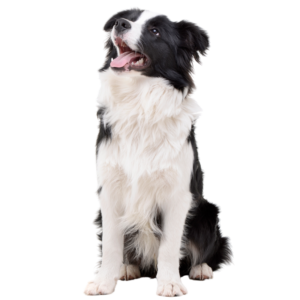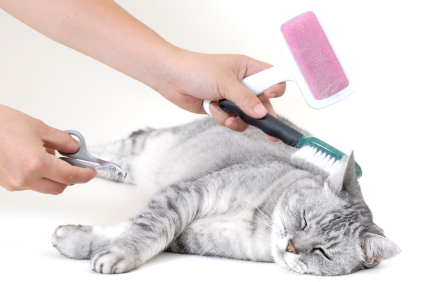Your animal is not self-cleaning.
Imagine going your whole life without having a bath, without having your hair brushed or cut, without having your nails trimmed or ears cleaned! Believe it or not we see this in veterinary medicine more often than one would think. Pets are brought in because:
“not feeling well”
“not eating”
“seems to be itchy all over”
“frantically scratching at her ears”
“digging at her eyes”
“Doesn’t seem as active as usual”
Many times a closer inspection quickly reveals the culprit: these pets are not being regularly groomed. A neglected hair coat can cause many medical issues – from infected skin to brutally painful ear and eye infections to infected pads on the feet etc. Often times these animals are in so much discomfort because the hair is pulled so tight due to matting, nails that are so long that they have curled up and are growing into the pads of the feet, ears are so raw and infected because they are so full of hair that air simply cannot get into them. It saddens us to know that this is so easily avoided if pet owners could take into consideration the time and money they’ll need to invest in grooming when they choose their pet. If you don’t have the financial resources or free time to devote to grooming your pet then please simply choose one that doesn’t require so much of it. Below I’ll list some of the basic types of hair coats as well as some of the common breeds associated with them and the approximate amount of grooming required:
Super Short – Boxer, Doberman, Chihuahua, Weimaraner, Great Dane, German Shorthaired Pointer, Greyhound, Daschund, Boston Terrier etc. These breeds require minimal grooming with often just a monthly bath and/or once over with a grooming glove to help free debris and give a nice shine to the coat.
Short – Pug, Labrador Retriever, Mastiff etc. These breeds are often good with a quick brushing every week or 2 to remove dead hair.
Medium – Golden Retriever, German Shepherd, Border Collie etc. These breeds often require weekly brushing to remove dead hair and tangles (matts) especially along the neck, legs and tail where the hair tends to be longer
Long – Bernese Mountain Dog, Newfoundland, Old English Sheepdog, Rough Collie, Shetland Sheepdog, Bouvier des Flandres etc. These breeds often require DAILY brushing to keep their coats matt free and clean.
Double-coated – Siberian Husky, Alaskan Malamute, Akita, Great Pyrenees etc. These breeds also require more regimented grooming sometimes as often as a quick once-over with a brush designed for heavy shedders every day to remove the excess dead hair. These breeds have a very dense undercoat and shed an astronomical amount of hair!
Now we move on to the popular breeds that require hair CUTS:
Some breeds require more than just a bath and brushing. They need hair CUTS with a professional groomer sometimes as often as every 6-8 weeks. These breeds often require more meticulous care (facial grooming, ear plucking) This tab will usually run anywhere from $40 and up depending on the breed and size. The bigger the dog and/or grooming required = more time it takes to groom = bigger cost. Shih Tzu, Yorkshire Terrier, Poodle, Bichon Frise, Lhasa Apso, Old English sheepdog, Soft Coated Wheaton terrier, Bouvier des Flandres, etc. If you’re not so concerned about how *professional* looking the trim is you can always learn how to do the hair cut at home yourself.
When it comes to cats there is a misconception out there that because they are such notorious groomers they don’t require any extra help. We’ve even seen cases as bad as the skin being full of maggots underneath all those matts. Plus not to mention how painful that must have been! Healthy skin needs air circulation to remain healthy. Matted hair prevents that from happening. Persians and Himalayans are popular breeds that DO often require brushing every other day or more (I can personally attest to this as I’ve been owned by 2 persians in the past). Many owners opt to regularly shave their long-haired cats. This usually needs to be done every 3-4 months to prevent matting. Short haired cats still require regular brushing to remove dead hair; which means LESS for your cat to ingest when s/he’s grooming himself which means less digestive issues due to hairballs.
Hair brushing isn’t the only concern when it comes to grooming. Your pet will need to be bathed on occasion as well. How often depends, again, on the breed. It’s best to bathe your pet as little as possible as it strips the hair coat of natural oils which will lead to dry skin issues. If and when you DO need to bathe be sure to use pet formulated products (the ph requirements of animal hair is different than ours) Human products are often too harsh and many pets’ skin will react adversely to them.
Nail trimming is the most commonly neglected task. Many pet owners avoid it simply because their pet doesn’t like it. Many pets are quick to learn that biting or any display of aggression will stop owners dead in their tracks when it comes to nail trimming. The best trick for this is to start the grooming regime the moment you bring your pet home so s/he gets used to it. This includes nail trimming. Your pet should learn very early on that this is necessary and is just part of life. How often the nails need to be trimmed depends entirely on the dog. Some dogs require weekly nail trims – others only monthly – some rarely (these dogs are often very active outside – playing/running on pavement etc so the nails wear themselves down naturally. That being said the dewclaws do not touch the ground, therefore, will require you to trim them) A weekly inspection and trim as needed is advised. Your Veterinarian or clinic staff can easily teach you how to trim nails at home, however, if it’s just a task that you don’t want to do yourself there are many groomers or vet clinics that will do this for you for a fee. Cats also DO require nail trimming – once a month is often adequate. Remember, the younger the pet is when you introduce this, the easier it is for him/her to accept it
Let’s not forget the ears. Many breeds such as the Poodle, Shih Tzu, Soft Coated Wheaton Terrier, etc. often have very *hairy* ears. Too much hair prevents air circulation within the air which leads to extra moisture which is prime breeding ground for yeast and bacteria. These breeds will need regular ear maintenance in the form of hair plucking and/or trimming. This is something that either you can do yourself or your Vet/groomer can do it.
So there you have it folks. Please consider all the above when it comes to choosing your new furry family member. Sometimes even finding an extra 15 minutes in your day to devote to grooming is monumental nevermind 30+ or more. Owning a pet isn’t just about feeding and giving it a home; it’s about taking care of all of the basic needs.



